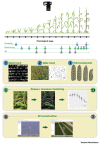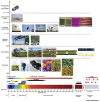Translating High-Throughput Phenotyping into Genetic Gain
- PMID: 29555431
- PMCID: PMC5931794
- DOI: 10.1016/j.tplants.2018.02.001
Translating High-Throughput Phenotyping into Genetic Gain
Abstract
Inability to efficiently implement high-throughput field phenotyping is increasingly perceived as a key component that limits genetic gain in breeding programs. Field phenotyping must be integrated into a wider context than just choosing the correct selection traits, deployment tools, evaluation platforms, or basic data-management methods. Phenotyping means more than conducting such activities in a resource-efficient manner; it also requires appropriate trial management and spatial variability handling, definition of key constraining conditions prevalent in the target population of environments, and the development of more comprehensive data management, including crop modeling. This review will provide a wide perspective on how field phenotyping is best implemented. It will also outline how to bridge the gap between breeders and 'phenotypers' in an effective manner.
Keywords: field phenotyping; genetic gain; high-throughput; remote sensing.
Copyright © 2018 The Authors. Published by Elsevier Ltd.. All rights reserved.
Figures




References
-
- Acreche M.M. Physiological bases of genetic gains in Mediterranean bread wheat yield in Spain. Eur. J. Agron. 2008;28:162–170.
-
- Sadras V.O. Genetic gain in yield and associated changes in phenotype, trait plasticity and competitive ability of South Australian wheat varieties released between 1958 and 2007. Crop Pasture Sci. 2011;62:533–549.
-
- Araus J.L., Cairns J.E. Field high-throughput phenotyping, the new frontier in crop breeding. Trends Plant Sci. 2014;19:52–61. - PubMed
-
- Ghanem M.E. Physiological phenotyping of plants for crop improvement. Trends Plant Sci. 2015;20:139–144. - PubMed
-
- Tardieu F. Plant phenomics, from sensors to knowledge. Curr. Biol. 2017;27:R770–R783. - PubMed
Publication types
MeSH terms
LinkOut - more resources
Full Text Sources
Other Literature Sources
Miscellaneous

